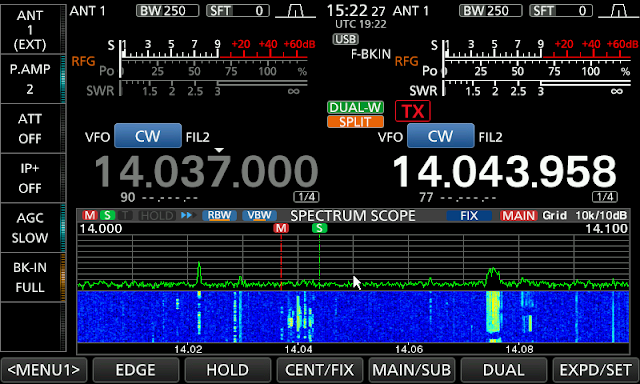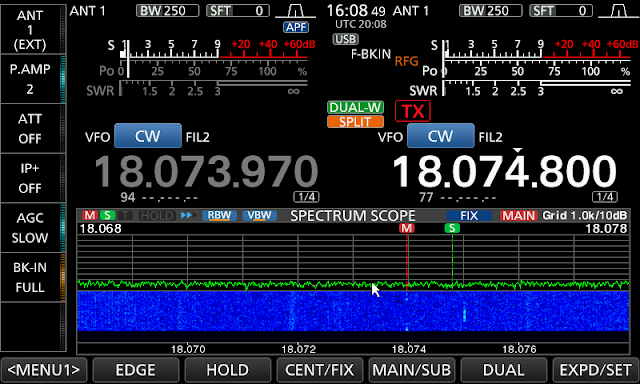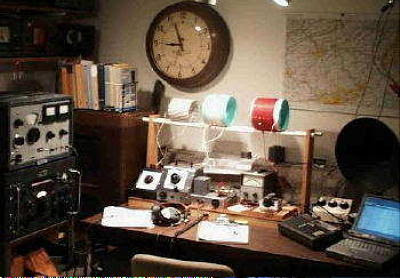 LHS Episode #438: Is That a Cubesat in Your Pocket?
LHS Episode #438: Is That a Cubesat in Your Pocket?
Hello and welcome to the 438th episode of Linux in the Ham Shack. In this short-topics episode, the hosts discuss the educational possibilities of ham radio, the proliferation of 5G, Russia and Ukraine's radio war, tiny satellites, tiny utilities , multi-radio SDRs and much more. Thank you for listening and have a wonderful week.
73 de The LHS Crew
Russ Woodman, K5TUX, co-hosts the Linux in the Ham Shack podcast which is available for download in both MP3 and OGG audio format. Contact him at russ@bluecows.com.
 Combined SOTA / POTA Activations
Combined SOTA / POTA Activations
Lately, Joyce/K0JJW and I have been doing combined Summits On The Air (SOTA) and Parks On The Air (POTA) activations. Most of the SOTA summits we activate are inside parks as defined by POTA. Our primary focus is using VHF/UHF from SOTA summits with POTA is being a nice addition. Although the two programs have a lot of similarities, there are some significant differences that need to be understood.

SOTA / POTA Differences
Let’s compare the two programs to understand the differences, so you can have a successful activation with both. We will focus on differences when doing an activation so this is not an exhaustive list.
- Summits Vs Parks. Well, this is the fundamental difference. Summits tend to be small in area, defined by a specific lat/lon coordinate and the surrounding activation zone (AZ). The activation zone is roughly defined as the area surrounding the actual summit, staying within 25 vertical meters. Parks can be almost any size and may cover many square miles. Both SOTA and POTA maintain lists of official summits or parks, so it should be clear whether one of these is valid for an activation.
- Accessibility. While there are drive-up and easy walk-up summits, most SOTA summits require a hike. Many of them are physically challenging. Parks often have easier, park-like access. Or you can always do a 50-mile backpack trip for a POTA activation.
- Equipment restrictions. SOTA allows you to reach the activation zone in a vehicle but you must move away from the vehicle an unspecified distant and operate totally independent of the vehicle. On drive-up mountains, our practical application of this rule is to load up our normal SOTA gear into backpacks, hike away from the vehicle, and set up for the activation. SOTA requires the use of portable power sources but not fossil-fuel generators. This pretty much means battery power, perhaps augmented with solar panels. POTA does not have such restrictions, so if you meet the SOTA requirements you’ll be valid for both.
- Scoring. SOTA emphasizes the accumulation of activator and chaser points, while layering in other challenges such as Summit-to-Summit (S2S) scores. Each summit has a point value assigned to it, based on elevation. In POTA, all parks are created equal and the main focus tends to be on the number of activations and the number of parks hunted (chased). POTA also has awards for the number QSOs. For example, the Kilo Award is achieved by making 1000 QSOs from a single park (usually over multiple activations). Both programs have quite a bit of variety and flexibility built into their awards and operating objectives, which is one of the reasons people enjoy the programs.
- Successful Activation. SOTA requires only one radio contact for a successful activation. But to receive point credit for the summit, which is what most people are after, you need to make at least 4 contacts. So most SOTA activators define success as getting at least four contacts. The 4 SOTA contacts must be with 4 different stations, with no credit for working the same station on multiple bands. In contrast, POTA requires 10 QSOs for a successful activation. POTA does count QSOs with the same station on different bands. For example, an activator could obtain the required 10 POTA QSOs by working just two stations on 5 different bands.
- Same Location QSOs. A SOTA activator does not get credit for working another station on the same summit. That is, the other station must be outside of the summit activation zone to be counted. POTA allows an activator to work another activator in the same park for QSO credit. In fact, the activators can receive park-to-park credit for such a radio contact.
VHF SOTA and POTA
Racking up lots of contacts on VHF/UHF from a summit can be a challenge, dependent mostly on the range of your gear and the ham population in the area. Most of the time, we can get four contacts without too much trouble but at times even that can be a challenge. Getting ten contacts for POTA raises the bar higher.
We noted that most of the hams we work on 2m FM are also workable on 70 cm FM. So an easy thing to do is to ask 2m chasers (hunters) to switch over to 70 cm and work us there, doubling the number of POTA-valid QSOs. Interestingly, the SOTA QSO count recorded in the database includes these QSOs. (But you must have contacted at least four unique stations to get the summit points.)
Because Joyce and I usually activate together, we can also work each other for POTA credit. I have discovered that many POTA activator teams make it a standard practice to pull out a couple of handheld radios and work each other on 2m FM when they first set up. OK, maybe that’s not the most exciting QSO of the day, but it is allowed. With a dual-band HT, you can make two QSOs this way. And it is a good idea to put out a call on 2m FM to work any locals that might be hunting parks. On a summit, these QSOs would not be valid for SOTA, unless one of the operators leaves the activation zone. Yes, we’ve done that, too, taking turns hiking down out of the AZ to make a quick contact.
Summary
This covers some of the things we’ve learned about doing combined SOTA and POTA activations. Again, this is with an emphasis on VHF/UHF operating. You should study the SOTA and POTA rules carefully because this article does not cover everything. However, some of the issues I’ve outlined here are not obvious from the SOTA and POTA rules, so I hope you find this article helpful.
73 Bob K0NR
The post Combined SOTA / POTA Activations appeared first on The KØNR Radio Site.
Bob Witte, KØNR, is a regular contributor to AmateurRadio.com and writes from Colorado, USA. Contact him at bob@k0nr.com.
 Ham College episode 82
Ham College episode 82
Ham College episode 82 is now available for download.
Extra Class Exam Questions – Part 20.
E5A Resonance and Q: characteristics of resonant circuits: series and parallel resonance, definitions and effects of Q, half-power bandwidth, phase relationships in reactive circuits.
1:05:41
George Thomas, W5JDX, is co-host of AmateurLogic.TV, an original amateur radio video program hosted by George Thomas (W5JDX), Tommy Martin (N5ZNO), Peter Berrett (VK3PB), and Emile Diodene (KE5QKR). Contact him at george@amateurlogic.tv.
 Zeroed in on another DXpedition……..
Zeroed in on another DXpedition……..
Yesterday I had a nice relaxing afternoon sitting at the 7610 checking out the bands. Solar conditions have been great the past while and that is a nice change to see. I was able to work 7P8RU again, and I did see the DXpedition HD8R from Galápagos spotted on DX summit . I was not able to hear them on 20m and barely on 40m, but then I saw them spotted on 17m. I found 17m to be very quiet, and I definitely saw HD8R on the waterfall but no pile up was being shown. I placed the Icom 7610 in Dual watch and split mode and found HD8R was working many stations, but most if not all I could not hear. The DX stations they were answering were mainly U.S. stations, so I realized the band was open in my direction. As I listened and I emphasize "listening". Now and then some U.S. stations were heard at my end working HD8R and this allowed me to get the team's strategy for working DX.
I blindly threw my call-out a few times, and very soon after I heard VE9KE 599....I came back with VE9KK KK KK and low and behold the call was corrected, and I was in their log. Once again 100 watts and my Endfed antenna came through for me.
This weekend is the CQWW SSB contest and for the SSB folks this is a big one. There is going to be lots of rare DX to be had for sure. For me I am a CW guy and not because I snub SSB but because in the past when operating SSB I have caused issues with neighbours. I am going to see if the rare CW stations have less of a pileup this weekend because of the SSB contest and many will be operating in that.
Mike Weir, VE9KK, is a regular contributor to AmateurRadio.com and writes from New Brunswick, Canada. Contact him at ve9kk@hotmail.com.
 LHS Episode #437: The Weekender LXXXI
LHS Episode #437: The Weekender LXXXI
It's time once again for The Weekender. This is our bi-weekly departure into the world of amateur radio contests, open source conventions, special events, listener challenges, hedonism and just plain fun. Thanks for listening and, if you happen to get a chance, feel free to call us or e-mail and send us some feedback. Tell us how we're doing. We'd love to hear from you.
73 de The LHS Crew
Russ Woodman, K5TUX, co-hosts the Linux in the Ham Shack podcast which is available for download in both MP3 and OGG audio format. Contact him at russ@bluecows.com.
 The art of working split to contact a DXpedition.
The art of working split to contact a DXpedition.
 |
| Contacting 7P8RU |
Yesterday afternoon while on 20m I noticed a large gathering around 14.040. After a little investigating, I found it to be the 7P8RU DXpedition from Lesotho located in South Africa. The team were excellent CW operators and this made for a very organized pileup. As I listened to find out how they were working the pileup I found that as always operators trying to contact 7P8RU on their calling frequency. With most if not all DXpeditions they operate split, meaning they call CQ on one frequency and listen on another. Their listening frequency can vary from 1kHz to 5kHz span.
I find it best to listen to the DX station and also those trying to contact the DX station. This is done to learn how the DX station is working "the pileup"..... those who are trying to make contact. Most if not always the DX station has a pattern on how they contact calling stations. Other times they indicate specific regions they only want to contact. It's best to listen first and find out the DX's rhythm, and also if they are working a region of the world that you are not in. This avoids you calling not getting answered and the DX station wondering why you're not listening to instructions. This just brings about frustrations at both ends.
Now down to the nitty-gritty of making contact! Once you have listened and found out the DX rhythm and that he is working stations in your part of the world, it's time to jump in the fray. But wait, how does one listen to both the DXpedition and perspective contact stations, who are 1-4 kHz away? This is where rigs with 2 independent receivers come in very handy. The 2 independent receivers allows you to hear VFO A and VFO B at the same time or the DX and those who are trying to contact them. In my case I use headphones with VFO A in my left ear and VFO B in my right ear.
They do say that a picture is worth a thousand words....and with DXpeditions this is also very true. It's great to hear both sides but adding a visual representation is fantastic! This is done with a radio that has a spectrum scope. Now you are able to hear and see each station the DX is working. As the DX either moves up or down the band, you can fit your signal in the pathway and toss out your call and see if you are heard.
The Icom 7610 has all the above-mentioned bells and whistles, as do many other HF and SDR rigs. The picture above is a screenshot of my 7610 setup to work 7P8RU. I have turned on "Dual watch" this allows me to hear both VFO A (main) and B (sub) Split has been turned on, so I transmit on VFO B and not on top of 7P8RU on VFO A.
On the spectrum scope, the red M is the main VFO A, and it is set on 7P8RU's calling frequency. The crowd of signals to the right (between M and S) are those calling the DXpedition station. The green "S" is my sub VFO marker and tells me where my transmit signal will be.
One nice thing about the scope, once 7P8RU has contacted a station, most times you can see this station visually answering the DX station. By watching this interaction you get an idea of how the DX station is working the pileup. The above picture shows the scope giving a band slice of 100 kHz and you can see t FT8 to the far right and toward the bottom of the band other CW signals. When working the DXpedition I have the scope set to a narrow slice of the band, so I can get a better picture of the pileup and who is being worked by the DX.
It's great fun to work these stations when you can hear them, and it gives you a good workout on learning your radio and what it can do. In my case 7P8RU was contacted and is in the log!
Mike Weir, VE9KK, is a regular contributor to AmateurRadio.com and writes from New Brunswick, Canada. Contact him at ve9kk@hotmail.com.
 The Crystal Radio DX Contest
The Crystal Radio DX Contest
I first became intrigued with Crystal Radio DXing several years ago when I happened across the above image showing the Crystal Radio DX Contest setup of Al Klase, N3FRQ. I was immediately surprised to learn that 'DX' could actually be heard on a crystal radio ... I could never hear anything but two strong locals on my own crystal set as a kid. I also knew immediately that I wanted to learn more and hopefully get into the next Crystal Radio DX Contest!
Back then, the contest was organized by the Yahoo Crystal Radio Group and then later, by the Alabama Crystal Radio Group. These contests were exceptionally popular and always sparked a huge amount of discussion, spurred new construction and seemed to create a lot of ‘crystal radio’ excitement in the months leading up to the contest.
Crystal radios can be as simple as a 'single-tuned' set like this, built by Mike Simpson from plans shown in Alfred P. Morgan's "The Boys' Third Book of Radio and Electronics". Read the nice back-story from Mike about this project! In the right location and with a good antenna, even simple sets like this are capable of hearing skywave signals.
| (courtesy Mike Simpson http://www.analogdial.com) |
At the other end of the spectrum are elaborate DX sets like this one, built by Mike Tuggle in Hawaii.
| Mike Tuggle's 'Lyonodyne' DX set | |
Mike regularly hears AM broadcast band stations in Canada and the USA on his crystal radio from his location in Hawaii ... he explains the details here.
Recently, along with Doug (K4LY) and Dave (N1DAY), I discussed how we might be able to again resurrect this popular contest activity and after countless e-mail exchanges, we’ve now put together just such an event!
Accordingly, we invite any and all crystal radio builders and users to participate in the upcoming Crystal Radio DX Contest to be held from January 1 through January 8th, 2022!
This date period should provide ample time for new construction to take place or to make improvements to present radios, while hopefully finding some nice mid-winter propagation on the broadcast band … half the battle when it comes to DXing with crystal radios.
Some ideas have been gleaned from previous contests to provide a minimum set of simple rules that will hopefully accommodate crystal radios of all types.
There are two entry classes, ‘OPEN’ and ‘HOBBY’ with guidelines for each. You will only be competing against others in the same category or maybe only against yourself if trying to reach a set goal.
In the true spirit of previous contests, it’s more about having fun, optimizing your passive receiving system and creating some great discussions, both before and after the contest … this really makes every participant a winner in the end.
As an anchor point for discussions regarding this and future such events, the Facebook ‘Crystal Radio DX Contest Group’ has been created and anyone that might be curious or interested in possible contest participation is encouraged to join.
In no way is this group intended to usurp activity from any present groups and it should not. It will be a focal point where members can find and discuss activities generated by the upcoming event. What are you building or improving for the contest? What are your plans? Share your crystal radio DXing strategies. Any thoughts or comments related to the upcoming event are fair game!
The Crystal Radio DX Contest Group can be found here where you can find discussion as well as the rules.
As well, the rules in pdf form, may be found here if you are not on Facebook.
Hopefully you will consider entering the contest ... it was always an enjoyable event.
Steve McDonald, VE7SL, is a regular contributor to AmateurRadio.com and writes from British Columbia, Canada. Contact him at ve7sl@shaw.ca.

















